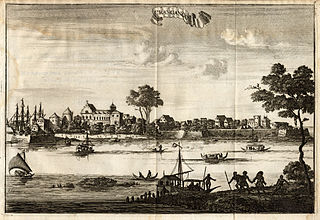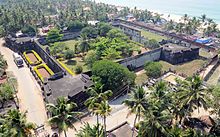
Varkala is a major coastal municipality situated in the northern suburb of Trivandrum, capital city of the Indian state of Kerala. It is the headquarters of Varkala Taluk and important government institutions such as the taluk office, court complex, office of the Deputy Superintendent of Police, Legal Metrology Inspector office, Excise Circle and Range office, RTO, Treasury and Mini civil station are situated in here. It is one among the oldest municipalities of Kerala established on 1980.

Kodungallur is a historically significant town situated on the banks of river Periyar on the Malabar Coast in Thrissur district of Kerala, India. It is 29 kilometres (18 mi) north of Kochi (Cochin) by National Highway 66 and 38 km (24 mi) from Thrissur. Kodungallur, being a port city at the northern end of the Kerala lagoons, was a strategic entry point for the naval fleets to the extensive Kerala backwaters.

Kerala Varma Pazhassi Raja, also known as Cotiote Rajah and Pychy Rajah, was the de facto head of the Kottayam Kingdom in the Malabar region of Kerala between 1774 and 1805. His struggles with the British East India Company is known as the Cotiote War. Pazhassi's rebellion against the British is often touted as one of the earliest acts of freedom fight in India. He earned the epithet "Kerala Simham" on account of his martial exploits.

The Battle of Colachel was fought on 10 August 1741 [O.S. 31 July 1741] between the Indian kingdom of Travancore and the Dutch East India Company. During the Travancore-Dutch War, King Marthanda Varma's (1729–1758) forces defeated the Dutch East India Company's forces led by Admiral Eustachius De Lannoy on 10 August 1741. The Dutch never recovered from the defeat and no longer posed a large colonial threat to India.

Rama Varma I often referred to as Dharma Raja, was the Maharajah of Travancore from 1758 until his death in 1798. He succeeded his uncle Marthanda Varma, who is credited with the title of "maker of modern Travancore". During his reign Dharma Raja not only retained all the territories his predecessor had gained but administered the kingdom with success. He was addressed as Dharma Raja on account of his strict adherence to Dharma Sastra, the Hindu principles of justice by providing asylum to thousands of Hindus and Christians fleeing Malabar during the Mysorean conquest of Malabar.
The history of Thiruvananthapuram dates back to the 18th century AD. In 1795, the city became the capital of the princely state of Travancore. Several historic landmarks of the city, including the Kowdiar Palace, University of Kerala, and Napier Museum were built during that period. After independence, Thiruvananthapuram was made the capital of the state of Kerala.

The Travancore–Dutch War was a war between the Dutch East India Company (VOC) and the Indian kingdom of Travancore, culminating in the Battle of Colachel in 1741.

The Samoothiri was the hereditary Nair monarch and ruler of the Kingdom of Kozhikode (Calicut) in the South Malabar region of India. Originating from the former feudal kingdom of Nediyiruppu Swaroopam, the Samoothiri and his vassal kings from Nilambur Kovilakam established Calicut as one of the most important trading ports on the southwest coast of India. The 147th Samoothiri Raja, Sree Manavedan Raja, who was married to Bharathy Thamburatty from Nilambur Kovilakam, became the last Zamorin in the dynasty's 682 year history to hold power over the Guruvayur Temple. At the peak of their reign, his ancestors ruled over a region extending from Kozhikode Kollam (Kollam) to the forested borders of Panthalayini Kollam (Koyilandy). The Zamorins belonged to the Eradi caste of the Samantan Nair community of colonial Kerala.

Sarkaradevi Temple is one of the most important temples in South India. It is situated Chirayinkeezhu town in Thiruvananthapuram district. Tradition accords a remote antiquity to this temple. Its main deity is Bhadrakali. The Sarkaradevi Temple assumed a significant status for many reasons and rose to historical importance mainly with the introduction of the famous Kaliyoot festival by Anizham Thirunal Marthanda Varma, the Travancore sovereign, in 1748. The Sarkaradevi Temple have some basic attachment with Nakramcode Devi Temple which located in Avanavanchery, Attingal.

"Aswathi Thirunal" Umayamma, known as Queen Umayamma or Queen Ashure (Aswathi), (died 1698), was the regent queen of Venad (Venatu) in southern India from 1677 to 1684 on behalf of her young nephew (son of her older sister Senior Queen Makayiram Thirunal) Ravi Varma. She also served as the Junior Queen of Attingal under Senior Queen Makayiram Thirunal and subsequently as the Senior Queen of Attingal.

The Travancore royal family was the ruling house of the Kingdom of Travancore. They had to give up their ruling rights in 1949 when Travancore merged with India and their political pension privileges were abolished in 1971. The family is descended from the Ay/Venad family and the Chera dynasty.

Anchuthengu, formerly known as Anjengo, Angengo or Anjenga, is a coastal panchayath and town in the Thiruvananthapuram District of Kerala. It is situated 9km south-west of Varkala Town along Trivandrum - Varkala - Kollam coastal highway.

Maharani Bharani Thirunal Lakshmi Bayi CI was the Senior Rani of Travancore from 1857 till her death in 1901. Her consort was the famous poet and writer, styled the father of Malayalam literature, Sri Kerala Varma Valiya Koil Thampuran.

The Mysorean invasion of Malabar was the military invasion of the Malabar region of Kerala, including the territories of the Zamorin of Calicut, by the then-de facto ruler of the Kingdom of Mysore, Hyder Ali. After the invasion, the Kingdom of Cochin to the south of Malabar became a tributary state of Mysore.

Attingal Outbreak refers to the massacre of 140 East India Company soldiers by native Indians and the following siege of Fort Anjengo. The Attingal Outbreak is often regarded as the first organized revolt against British authority in Malabar, Cochin, Travancore, and India itself. The main reason behind the resentment was large-scale corruption and the manipulation of black pepper prices by the company.

Koyi Thampuran was the title of the Prince Consorts of the Queens and Princesses of Travancore. The Koyi Thampurans' gained prominence and prestige in Kingdom of Travancore as they were the fathers of the then reigning Kings. In Travancore, there were ten clans of Koyi Thampurans. The most ancient were the ones settled at Kilimanoor ; others were Kirthipuram, Pallam, Paliyakkara and Nirazhi, Ananthapuram, Chemprol, Cherukol, Karazhma and Vatakkemadham.
Malappuram is one of the 14 districts in the South Indian state of Kerala. The district has a unique and eventful history starting from pre-historic times. During the early medieval period, the district was the home to two of the four major kingdoms that ruled Kerala. Perumpadappu was the original hometown of the Kingdom of Cochin, which is also known as Perumbadappu Swaroopam, and Nediyiruppu was the original hometown of the Zamorin of Calicut, which is also known as Nediyiruppu Swaroopam. Besides, the original headquarters of the Palakkad Rajas were also at Athavanad in the district.
Thalassery was a trade hub where Chinese, Arab, and Jewish traders had considerable influence in the spice market before that the Greeks and Romans was in the trade. It was the European invasion that brought significant change as they enforced the trade with their military.

HCS Coote was a sloop-of-war that served the British East India Company (EIC) during the 19th century. The Bombay Dockyard launched Coote in 1827. Though the EIC built Coote, her size and armament were equivalent to the retired Cruizer-class brig-sloops.
The H[onourable] C[ompany's] S[hip] Sylph was a schooner launched in 1806 at the Bombay Dockyard for the Bombay Marine, the naval arm of the British East India Company (EIC). The EIC sold her circa 1826 and she became a merchant brig. There is no mention of her in accessible online sources after 1828.



















